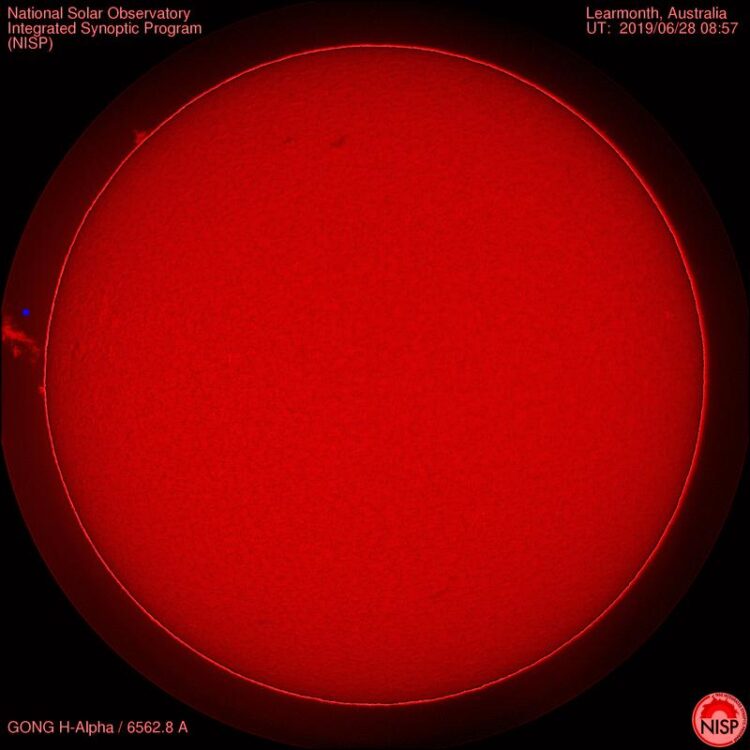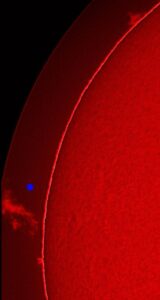How the Sun’s magnetic forces arrange gas particles

Researchers observed how magnetic forces lifted a prominence by 25,000 kilometres – about two Earth diameters – within ten minutes.
Credit: NASA/SDO and the AIA, EVE, and HMI science team; adjustments: AIP
Research team including Göttingen University observes charged particles 70 percent faster than uncharged.

Credit: NASA/SDO and the AIA, EVE, and HMI science team; adjustments: AIP
Solar prominences hover above the visible solar disk like giant clouds, held there by a supporting framework of magnetic forces, originating from layers deep within the Sun. The magnetic lines of force are moved by ever-present gas currents – and when the supporting framework moves, so does the prominence cloud. A research team from the University of Göttingen and the astrophysics institutes at Paris, Potsdam and Locarno observed how magnetic forces lifted a prominence by 25,000 kilometres – about two Earth diameters – within ten minutes. The results of the study were published in The Astrophysical Journal.
This uplift corresponds to a speed of 42 kilometres per second, which is about four times the speed of sound, in the prominence. Oscillations occurred with a period of 22 seconds, during which positively charged ions of iron were up to 70 per cent faster than neutral helium atoms. The charged iron ions have to follow the movement of the magnetic field but the uncharged helium atoms are not affected in the same way. In fact, the helium atoms are carried along by the ions, but only partly because there are not enough collisions between the two types of particle since the gas pressure is too low.
Such conditions – where partially ionised gas exists with few collisions – play an important role in astrophysics. Their role is not just demonstrated in solar prominences, but also in the following: the huge gas clouds from which stars and planets form; the gas that fills the vast expanse between stars; and in the gas between galaxies. Theoretical astrophysicists have already simulated such conditions as two fluids interacting only weakly with each other. “Some of the previous assumptions used in model calculations can now be verified thanks to these new measurements in our results,” says Dr Eberhard Wiehr from the Institute for Astrophysics at the University of Göttingen.
The team carried out the observations at the solar telescope in Locarno, where it is only possible to measure two emission lines simultaneously. Now the scientists are planning extended observations at the French telescope on Tenerife, where several lines can be measured at the same time. In addition, the light intensity for this telescope is increased four-fold, which will enable such a short exposure time for the light-sensitive cameras that even shorter oscillation periods will be measurable. “We may then find even higher velocity differences between the charged ions and the neutral atoms,” added Wiehr.
Original publication: Eberhard Wiehr et al. Velocity difference of ions and neutrals in solar prominences. Astrophysical Journal (2021). Doi: https://iopscience.iop.org/article/10.3847/1538-4357/ac1791
Contact:
Dr Eberhard Wiehr
University of Göttingen
Institute for Astrophysics
Friedrich-Hund-Platz 1, 37077 Göttingen, Germany
Email: ewiehr@gwdg.de
Journal: The Astrophysical Journal
DOI: 10.3847/1538-4357/ac1791
Method of Research: Observational study
Subject of Research: Not applicable
Article Title: Velocity difference of ions and neutrals in solar prominences
Article Publication Date: 13-Oct-2021
Media Contact
Melissa Sollich
University of Göttingen
melissa.sollich@uni-goettingen.de
Office: 49-551-392-6228
Original Source
All latest news from the category: Physics and Astronomy
This area deals with the fundamental laws and building blocks of nature and how they interact, the properties and the behavior of matter, and research into space and time and their structures.
innovations-report provides in-depth reports and articles on subjects such as astrophysics, laser technologies, nuclear, quantum, particle and solid-state physics, nanotechnologies, planetary research and findings (Mars, Venus) and developments related to the Hubble Telescope.
Newest articles

NASA: Mystery of life’s handedness deepens
The mystery of why life uses molecules with specific orientations has deepened with a NASA-funded discovery that RNA — a key molecule thought to have potentially held the instructions for…

What are the effects of historic lithium mining on water quality?
Study reveals low levels of common contaminants but high levels of other elements in waters associated with an abandoned lithium mine. Lithium ore and mining waste from a historic lithium…

Quantum-inspired design boosts efficiency of heat-to-electricity conversion
Rice engineers take unconventional route to improving thermophotovoltaic systems. Researchers at Rice University have found a new way to improve a key element of thermophotovoltaic (TPV) systems, which convert heat…



